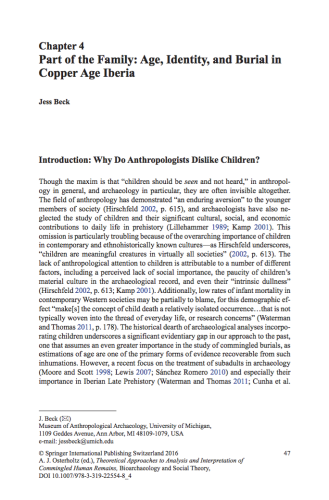I don’t spend a vast amount of time on the blog talking about my own bioarchaeological research in Iberia, in part because it already consumes so much of the rest of my life, and in part because it is rarely an appropriate forum for posting amusing pictures of animals. However, if you have been on tenterhooks as to the results of my summers spent in a museum basement in Jaén, you’re in luck: I contributed a chapter to the Springer edited volume Theoretical Approaches to Analysis and Interpretation of Commingled Human Remains that was just published.

The chapter summarizes some of the preliminary results of my Iberian research. In brief, it outlines the strategies I’ve used to turn thousands of fragments of human bones and teeth into concrete data about what life was like during the Copper Age. I’m particularly focused on how people buried their dead, and what that means about living societies and how they were organized. I’ve included the abstract and a link to the pdf below. If you’re a reader of the blog who is curious about my academic research, I think it’s worth a read. If you’re just here looking for funny pictures of cats, I would give this one a miss, but I highly recommend this post on isotopes instead.

Abstract: Recent work has called attention to the significant numbers of subadults recovered from Late Prehistoric burial contexts in western Iberia. However, subadult burials are also documented at some of the well-known, large-scale Copper Age centers of southeastern Spain, where adults and subadults are represented in both commingled and individual inhumations. The importance of the inclusion and mortuary treatment of subadults at such centers of social and economic activity has yet to be sufficiently explored. Here, I discuss the implications of the presence of subadults for the formation and representation of community identity, with particular emphasis on the case of Marroquíes Bajos. At this site, salvage excavations have yielded evidence of five concentric ditches and one adobe wall that encompass an area of approximately 113 ha, making it one of the largest “matrix villages” of the Iberian Copper Age. Marroquíes Bajos is also a particularly relevant case because subadults occur in formally and spatially distinct funerary contexts. Their remains appear in mortuary structures housing only fragmentary and commingled remains, in mortuary structures housing discrete primary and secondary interments, and in a large, commingled interment in an artificial cave. The significance of subadult burials at Marroquíes Bajos is explored relative to theoretical interpretations of childhood in prehistory, in particular relative to ethnographically and archaeologically documented rites of passage.
PDF Here: Beck 2015 – Part of the Family – Age, Identity and Burial in Copper Age Iberia
Thanks to the Museo de Jaén for their tremendous support while collecting data, Pedro Díaz-del-Río, Anna Waterman and Jonathan Thomas for feedback on initial drafts and ideas, and Anna Osterholtz for her assistance on the editorial side of things.


Congratulations! I’m looking forward to reading it properly. I’ve also just handed in a chapter for an edited volume, quite nerve-wracking!
LikeLike
Pingback: Bone Broke Year in Review 2015 | Bone Broke
I’m in the middle of reading the chapter, but it’s already been so informative. I never realized how little anthropology focuses on children, even though they are an important part of society. It’s interesting to see how burials can provide information about the status of subadults in the prehistoric past.
LikeLike
Hi Ashley,
Happy to hear that you’re finding the chapter interesting! If you’re starting to explore the archaeology of childhood, both Kathryn Kamp (Grinnell) and Sian Halcrow (University of Otago) do a lot of fascinating work on the archaeology of children and childhood. Sian is on Twitter and has a blog as well. If you’re interested in Iberia, my friends Anna Waterman and Jonathan Thomas have a great paper out called “When the Bough Breaks: Childhood Mortality and Mortuary Practice in Late Neolithic Atlantic Europe” that I highly recommend (you can find the citation in my chapter).
LikeLiked by 1 person